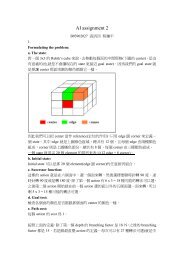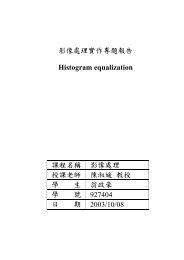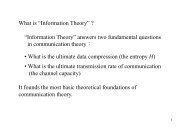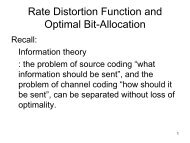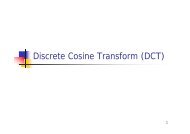Exaggeration of Facial Features in Caricaturing
Exaggeration of Facial Features in Caricaturing
Exaggeration of Facial Features in Caricaturing
Create successful ePaper yourself
Turn your PDF publications into a flip-book with our unique Google optimized e-Paper software.
Figure 4. Left: Orig<strong>in</strong>al pictures. Right: Marked with key po<strong>in</strong>ts (yellow, blue) and control po<strong>in</strong>ts (red).<br />
3.3 <strong>Facial</strong> <strong>Features</strong> Draw<strong>in</strong>g<br />
We have mentioned that each pair <strong>of</strong> neighbor<strong>in</strong>g po<strong>in</strong>ts<br />
has its own function <strong>of</strong> the Bezier curve. These functions are<br />
very simple but their result can simulate those actual<br />
outl<strong>in</strong>es very closely. We know that a curve is completely<br />
def<strong>in</strong>ed by four po<strong>in</strong>ts – known as control po<strong>in</strong>ts – p0, p1, p2<br />
and p3. Because p0 is the start<strong>in</strong>g po<strong>in</strong>t and p1 is the end<br />
po<strong>in</strong>t, we set the pair <strong>of</strong> po<strong>in</strong>ts as p0 and p3. We separate the<br />
<strong>in</strong>terval between p0 and p3 <strong>in</strong>to 3x3 equal parts so that p1<br />
and p2 are always at the boundaries depend<strong>in</strong>g on different<br />
circumstances. An example <strong>of</strong> the control po<strong>in</strong>ts <strong>of</strong> a right<br />
eye is shown <strong>in</strong> Figure 4.<br />
3.4 Hair Draw<strong>in</strong>g<br />
Draw<strong>in</strong>g hair is one <strong>of</strong> the important parts <strong>of</strong> our system<br />
because a face without hair is not natural. Users can <strong>in</strong>dicate<br />
four po<strong>in</strong>ts to let our system know where the hair is. Those<br />
four po<strong>in</strong>ts are respectively responsible for the locations <strong>of</strong><br />
upper–right, upper–left, lower–right, and lower–left.<br />
Beg<strong>in</strong>n<strong>in</strong>g with those four po<strong>in</strong>ts, we f<strong>in</strong>d black hair by the<br />
bread-first search (BFS) algorithm. If the color value<br />
difference between the next pixel and the current pixel is<br />
over a threshold, we mark that next pixel as the hair<br />
boundary.<br />
3.5 Tone–Shad<strong>in</strong>g<br />
Figure 5 .Hair draw<strong>in</strong>g algorithm<br />
The purpose <strong>of</strong> coloration is to emphasize the three–D<br />
effect. We don’t color the face depend<strong>in</strong>g on the <strong>in</strong>put<br />
B<br />
B<br />
B<br />
B<br />
B<br />
B





